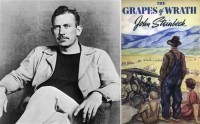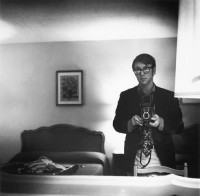The following is an excerpt from the third chapter of Collecting, Curating, And Researching Writers' Libraries, A Handbook, edited by Richard Oram and Joseph Nicholson (Rowman & Littlefield, 2014). This chapter deals with the role of the bookseller; other chapters deal with the roles of librarians, curators, and researchers, with accounts of some libraries, a list of authors' libraries preserved in public and private hands, and interviews conducted by Oram and MacDonnell with five well-known authors who describe candidly just how they organize and use their books. In this chapter MacDonnell outlines the five-stage process a bookseller employs when assessing a writer's library: defining what is in the library; assessing its salability; providing valuation; preparing the library for sale; and finally, negotiating its sale. The full article, as well as information on how to order a discounted copy, can be found here. III. The First Order of Business: Defining the Library A bookseller's first order of business when dealing with an author's library is defining just what comprises the author's library. This sounds simple, but books are often mixed with magazines and miscellaneous papers, and the day may soon be coming when an author might have more titles stored on his e-reader than on his shelves. An author might also have listened to audio books, now lurking on CDs or MP3s in some nearby device like a laptop, or iPhone, etc. Distinguishing an author's library from a “household�... [more Writers’ Libraries: The Bookseller’s Perspective]
As if the Islamic State of Iraq and the Levant's (ISIL; also referred to as IS, ISIS, and Daesh) actions weren't troubling enough, last week the US Department of State reported on the irrevocable damage the terror organization continues to wreak on cultural artifacts in Iraq and Syria. The destruction goes beyond wartime collateral damage– ISIL is celebrating their destruction of religious monuments and profiting from the systematic looting taking place. Corine Wegener, a cultural heritage preservationist at the Smithsonian Institution, called the current situation "one of the biggest problems to confront the cultural heritage community in decades." Secretary of State John Kerry joined Thomas Campbell, Director of the Metropolitan Museum of Art, in hosting a conference last week at the Met to call attention to the issue. Some remarks from Secretary of State Kerry: We gather in the midst of one of the most tragic and one of the most outrageous assaults on our shared heritage that perhaps any of us have seen in a lifetime. Ancient treasures in Iraq and in Syria have now become the casualties of continuing warfare and looting. And no one group has done more to put our shared cultural heritage in the gun sights than ISIL. ISIL is not only beheading individuals; it is tearing at the fabric of whole civilizations. It has no respect for life. It has no respect for religion. And it has no respect for culture, which for millions is actually the foundation of life...ISIL is stealing ... [more Destruction of Cultural Artifacts in Iraq and Syria]
Two weeks ago, I was in York for the inaugural York Antiquarian Book Seminar (a British equivalent of the highly successful Colorado Antiquarian Book Seminar). The whole experience was hugely invigorating. Here were 25 students, young and old, starting out in the rare book trade, full of promise, eagerness— and questions! One of the sessions I led was on cataloguing. For, as Roger Gaskell notes in his Terms of the Trade, "a large part of the trade in antiquarian books is conducted by catalogues, whether printed or online, and books offered in shops or at book fairs will usually be accompanied by a written description." It's those printed catalogues I want to talk about today. Earlier this year, Lorne Bair, on this very blog, waxed eloquently on the benefits of producing printed catalogues, and I agree with him wholeheartedly. People often ask me about my printed catalogues (six to date), so I thought I would share something of their history here. I set up on my own in January 2010, and right from the start I knew I wanted to do printed catalogues. I could have just sold books by e-mail, sending out PDF lists of what I have (and I do do that, too), but book collectors like books, physical objects that they can carry around, read on the bus, write comments on, mark by turning over the corner of a page. Because it is so easy now (and, of course, much cheaper) to create one's own catalogues, in Word or whatever with a few scans dropped in, that is what many booksellers do, but ... [more Catablog]
To mark the 75th Anniversary of 1939, we've asked some ABAA members to discuss publications from that momentous year. Marc Selvaggio, whose specialties include World's Fairs and International Expositions, takes us down memory lane as he examines the publications of the 1939 World's Fairs held in New York and San Francisco. On September 23rd, 1938, a group of men in dark suits gathered around a construction site in Queens and watched as a 90-inch, 800-pound cylinder, made of the special new alloy called “Cupaloy,” was lowered down a 500-foot tube. The solemn ceremony involved in the placement of this cylinder—officially known as the Westinghouse Time Capsule– inaugurated the site for the New York World's Fair. The Fair itself opened to an enthusiastic public on April 30, 1939. Meanwhile independent of the planning frenzy in New York, crews were busy creating a fabricated spit of land in the middle of the San Francisco Bay, a square 400-acre piece of artificial land-fill that would be romantically labeled, “Treasure Island.” Here, on February 18, 1939, the Golden Gate International Exposition was officially opened. Both Fairs would return in 1940, more to correct their balance books (ultimately, unsuccessfully) than for public demand. The Westinghouse Time Capsule contained what its creators considered “a complete record of our civilization”—a selection of fabrics, a fountain pen, seeds and metals, a slide rule, Barney Google comics, microfilm of hundreds of b... [more 1939: Before The War, The Fairs]
This item is still missing as of 5/29/2019. The following item has been reported stolen from a personal library in Texas: Lady Chatterley's Lover by D.H. Lawrence First Edition. Signed and numbered, No 249. If you have any information reagding this item, please contact Shannon Dorsey at (512) 922-2185 or shannonrose.dorsey@gmail.com. [more Stolen: Signed First Edition of ‘Lady Chatterley’s Lover’]
SELLING ON FACEBOOK? In my last post I talked a lot about the advantages of having a Facebook account for your business, including interacting with customers and colleagues, sharing content, getting “liked,” and learning about trends in your field; or, as one friend of mine put it, “the warm fuzzies.” So let's switch into copper baron mode here and discuss the other dimension that you've all been wondering about: how do we turn the warm fuzzies into customers and sales? The truth is that it takes time to build a following and reap the rewards of social media engagement. The real reward, in my opinion, is realized in the long-term with enriched interactions with your audience, a boost in your reputation, and more sales through your website as a result. But I would be remiss to not discuss a few other options at your disposal, so I want to look at two specific features that have been hot topics lately: Facebook storefronts and Facebook advertising. To make things simple, I'll split these services into two posts and begin today with the storefront. I actually have some pretty firm opinions about selling on Facebook (which I will share at the end for those of you who are interested), but I believe the choice is always yours. What works for one brand may not be right for another. And full disclosure: I am writing the following after careful research, not through personal experience as in previous posts, so please keep that in mind and if something piques your interest, do ... [more THE SAVVY BOOKSELLER: Social Media for the Antiquarian Book Trade, Post #4]
We are thrilled to announce that the winners of this year's National Collegiate Book Collecting Contest: First Prize: Katya Soll, University of Kansas, Dictatorship, Recovery, and Innovation: Contemporary Theatre of the Southern Cone Second Prize: Hanna Kipnis King, Swarthmore College, "Plucked from a holy book": Ashkenazim on the margins Third Prize: Audrey Golden, University of Virginia, Pablo Neruda and the Global Politics of Poetry First Prize Katya Soll, Dictatorship, Recovery and Innovation: Contemporary Theater of the Southern Cone Missouri native Katya Soll is a doctoral candidate in Theatre and Spanish at the University of Kansas. Her collection focuses on how theater has been a conduit through which citizens in South America's Southern Cone have protested, absorbed, and recovered from dictatorship and oppression. Many parts of the collection were purchased during research trips to Argentina, Uruguay, and Chile. Second Prize Hanna Kipnis King, "Plucked from a holy book": Ashkenazim on the Margins Hanna Kipnis King is a student at Swarthmore College and the winner of Swarthmore's A. Edward Newton Book Collection Competition. Her collection deals with the disenfranchised members of the Ashkenazi Jewish community, and how they have dealt with inadequate acceptance within its culture and traditions. Hanna gravitates to the poets, zinesters, novelists, theologians, and diarists; those that are writing in divergent and deeply personal ways of their experiences of misogyny,... [more National Collegiate Book Collecting Contest Announces 2014 Winners]
To mark the 75th Anniversary of 1939, we've asked some ABAA members to discuss publications from that momentous year. Jim Dourgarian, a specialist in Steinbeck (among other authors), recounts his experiences reading and selling The Grapes of Wrath. The 1930s were a turbulent and momentous decade for John Steinbeck. He published such diverse and quality books as The Pastures of Heaven, Tortilla Flat, In Dubious Battle, Of Mice and Men, The Red Pony, and finally, on April 14, 1939, his masterpiece— The Grapes of Wrath. I had been introduced to Steinbeck as a high school freshman. My English teacher said we could read only one of his books per semester because he was “too brutal,” but brutal was exactly what I wanted. I was hooked. Steinbeck spoke for the underdog, the oppressed— and that was me! And many of the people who populated his books seemed to be my people. Both sets of my grandparents were poor. They struggled mightily, all while maintaining their dignity and belief in hard work. Eventually I read The Grapes of Wrath. It's a 600-page book, and I am not a speed reader, but I liked the story. And I even liked wading through the inner chapters wherein Steinbeck writes of man's struggle and agricultural politics. I probably read it for the first time in the equally turbulent 1960s. Comparing those decades, the 1930s and the 1960s, was a revelation. Not much had changed. The Man still oppressed the people. The fear of communism was ever-present. Rage against the Mac... [more 1939: The Grapes of Wrath]
ABAA member Raymond Smith (R.W. Smith Bookseller) recently published In Time We Shall Know Ourselves, a book of 52 photographs taken during his three-month road trip through the Eastern half of the United States in 1974. Publication of the book coincided with a traveling exhibition of the photographs that commenced at the Montgomery Museum of Fine Arts in June. The exhibition will be on display at the Hickory Museum of Art from October 4, 2014-January 4, 2015; the Museum of Contemporary Art in Jacksonville, FL from April 23-August 23, 2015; and finally at the Georgia Museum of Art from October 25, 2015-January 3, 2016. In addition to the 52 photographs printed in duotone, In Time We Shall Know Ourselves also includes three critical essays, Richard H. King's “Mirror with a Memory”; Alexander Nemerov's “First and Last: The Sequence of In Time We Shall Know Ourselves”; and Smith's “Retrospect." Nemerov writes, The easiest thing to say about Raymond Smith is that he follows in the tradition of Walker Evans and Robert Frank. Evans was his photography teacher at Yale in the early 1970s and Frank's book The Americans (1958) is a source Smith acknowledges for his own book. But neither of these associations touches the deepest energy of Smith's photographs... Traveling far and wide, Smith sought out his subjects in a way reminiscent of Evans and Frank. But unlike those photographers he was animated by a sense of the town studio as the place and soul of his interstate picture... [more Photography Book by Raymond Smith Published and the Subject of Traveling Exhibition]
In the 1980s a buddy of mine who worked for a union in Manhattan got to know some people who knew some people who made it possible for him to purchase a three family tenement in Greenpoint, Brooklyn. This deal required some social engineering because Greenpoint was a very tight neighborhood. I used to hang out there when I had business in New York, and I remember it as tidy but bleak, sporting long rows of asbestos clad tenements under gunmetal skies. When I parked my car and walked to by buddy's place, eyes followed me every step of the way. There were no people of color, just gray hair and white flesh. All the shop signs were in Polish. My car was safe but the streets were cold. I am here to tell you, friends, that Greenpoint has unfrozen. Now it teems with energy and diversity in that curious kind of vertical integration that characterizes recently colonized neighborhoods like the Lower East Side. Junkies and homeless people are still there, but they exist side by side with Euro babes walking teeny dogs, trendy hole-in-the-wall restaurants, and jogger moms pushing three wheeled carriages that cost more than my used Toyota. And those mind-bendingly spectacular views of The City! Where were they in the 1980s? This was the setting for the Brooklyn Antiques & Book Fair held in the brand new Brooklyn Expo Center in Greenpoint. The site had recently been purchased and turned into a giant cube of glass by a band of real estate operators - descendants, perhaps, of the guys who ho... [more Marvin’s Daughter]










